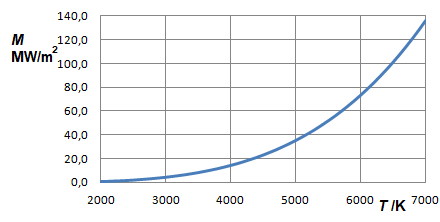2. الإشعاع الحراري
The role of temperature: the Stefan-Boltzmann law
We are interested in the area under the Planck spectra of black bodies, that were discussed in the previous section. These areas obviously increase in size with increasing temperature of the emitter. The way in which this happens shall be found through determination of the area underneath the graphs.
The calculation of the area results from integration of the Planck graphs. Presuming the frequency depiction of the spectral energy density
By integration one obtains the energy density of all possible frequencies
Calculating the integral may be slightly difficult. The procedure is shown in Supplement 2.3. The result is:
The specific emission given in W/m² of a black body, for example the radiative power coming out of a cavity radiator's opening, is in most cases more meaningful for practical application than the energy density in (Ws)/m³ resp. J/m³ on the inside of the cavity. The relation is:
The result is the Stefan-Boltzmann law:
With , and the Stefan-Boltzmann constant is obtained:
Source: Rainer Reuter, University of Oldenburg, Germany.

